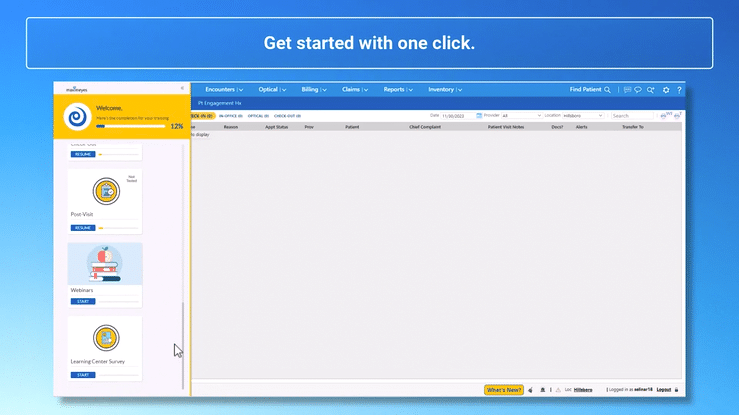
24 Jun How to Improve Patient Flow from Check-in to Check-out
Why is improving patient flow important for your eye care practice? The patient flow impacts staff performance, patient experiences, and revenue growth.
Patient flow is more than a daily logistical routine you set up with your staff. It’s about being intentional and creating a positive and welcoming environment that will earn you a reputation for attracting patient trust, loyalty, and satisfaction. It delivers smooth patient movement throughout your practice, from initial scheduling to final checkout.
Every interaction with patients is an opportunity to build trust and loyalty. Your reputation will ripple into their circle of friends and family during conversations. From the moment your patients walk through your doors to when they leave, each interaction should leave them with a positive impression of you and your staff.
In this blog, we’ll review 6 strategies for improving patient flow in optometry and ophthalmology practices.
1. Reduce scheduling restrictions with customizable schedule templates
Your reputation depends on how effectively you reduce scheduling restrictions and maintain your word when scheduling appointments. MaximEyes.com’s all-in-one eye care EHR, practice management, and patient engagement system allow you to customize your resource schedule. For instance:
- View appointments by day, doctor, or week.
- Easily build and change schedule templates in seconds.
- See doctor plans for scheduled patients from the scheduler.
- Use a quick search to find open appointments in one click and filter those by day of the week.
“We can easily build and change schedule templates in seconds. Simplified scheduling streamlines office workflows and enhances the patient experience by reducing wait times.” –April Bodily, Practice Administrator
2. Punctuality matters: text appointment reminders
Late arrivals disrupt the flow of appointments and can cause delays throughout the workday. Text appointment reminders to help patients arrive on time and avoid interruptions to your schedule.
An optometry and ophthalmology EHR system, such as MaximEyes.com, with built-in texting appointment reminders and other patient engagement tools, helps you stay on track with your schedule.
People have busy lives, and reminding them of their appointments is a great way to be intentional and simultaneously receive confirmation that their plans have stayed the same before their appointments. Many patients won’t answer the phone or check their voicemail, but they’ll see a text.
View MaximEyes.com Patient Engagement Video
3. Minimize patient wait times with online intake forms
Patients dislike waiting, especially if they have a busy life or must return to work. Use technology such as check-in apps, online patient intake forms, and pretesting procedures to reduce wait times and enhance the overall experience during check-in.
Your patients will earn your respect for respecting their time, allowing you to continue gaining their trust. That is why it is important to strategically manage your schedule and quickly make changes when needed.
“Collecting patient information before patients arrive at our office speeds up the check-in process. Patients love the intake forms, so they don’t have to come early to complete paperwork. When the patient finishes the form, the data transfers directly to the chart, eliminating time-consuming data entry.” –Davis Capaccioli, OD
4. Invest in staff education
Knowledgeable staff members are crucial in optimizing patient flow. Managing a multigenerational workforce is challenging for optometry and ophthalmology practices. Your staff is the backbone of your practice. However, if your team isn’t happy and motivated, your practice will not progress.
Provide comprehensive training to empower your team to deliver exceptional care efficiently, reducing the time spent on each patient encounter.
Your eye care software should provide ongoing educational resources, such as online resources and on-site training. For instance, MaximEyes.com gives you 24/7 access to a built-in Learning Center. Master workflows and processes with visual aids, images, documents, and examples.
MaximEyes.com Built-in Learning Center
5. Create a smooth office layout
Assess your practice layout to identify areas for improvement. Ensure you are using exam rooms to their full capability.
Consider expanding areas with a bottleneck to minimize wait times and enhance the patient experience. Your office design can make a huge difference when you have a full schedule, and your team can quickly get patients in and out smoothly.
Related: 9 Strategies for Managing a Successful Eye Care Practice
6. Upgrade your eye care patient exam processes
Invest in technology that facilitates quick access to patient data and imaging, reducing the time spent on each examination.
For example, cloud-based optometry EHR systems like MaximEyes.com and integrated ophthalmic imaging solutions like EyeClinic Imaging can significantly enhance efficiency and patient satisfaction. EyeClinic Imaging does not require VPNs, plugins, or extra software and works with any optometry and ophthalmology EHR.
“The images and testing results are automatically uploaded to EyeClinic Imaging, where I can review them with a single click directly from within MaximEyes.com. I can view images side-by-side to detect and annotate any changes. EyeClinic Imaging helps me educate patients on why they need these tests.” –Peter Falk, OD
Deliver Exceptional Eye Care by Mastering Patient Flow with MaximEyes.com
Create a patient flow management plan that will work best for you, then implement and test-run it. Make tweaks to your plan as you go. You will figure out what works best for your specific practice. Ultimately, what matters is having a practice you are genuinely proud of, which sets you apart from the rest.





